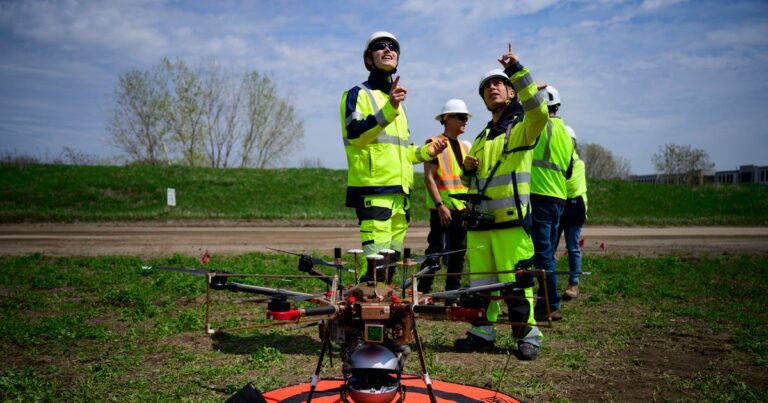A steady gust of wind whipped through a field in Maple Grove last week as Heimdall Power’s Warren Grange was flying a drone to attach what looked like high-tech cantaloupes to power lines.
The small, Norwegian-based spheres are officially called “neurons” and have nicknames such as “magic balls” and “orbs.” Whatever the name, electric cooperative Great River Energy plans to install 52 of these circular devices as a way to alleviate one of the most difficult problems facing the modern energy sector. Power companies are running out of space on transmission lines to transport the growing amount of wind power and other energy. More power lines are being built, but those infrastructure upgrades are often expensive.
The Heimdall technology is intended to flow more power along existing power lines, which Great River believes will delay major infrastructure work and save customers money. The nonprofit provides power to approximately 1.7 million people through 27 primarily rural cooperatives from northeastern Minnesota to the Iowa border.
Priti Patel, Great River’s vice president of transmission, said Orb “can unlock untapped capacity,” and no utility in the country has made such a big bet on the product.
Promoting pilot projects
Great River first tested Neuron, testing four of them in the Morris area last year. In this pilot project, he found information that with the provided sensors he could flow 42.8% more power into the power lines.
“If we can increase the transmission capacity of these lines, clean power will become more and more mainstream, but 40% is a big deal,” said St. Paul’s executive leader for policy and programs. Allen Gleckner said. Based at the non-profit organization Fresh Energy.
Heimdall CEO Jørgen Festavoll said most power companies have to operate their grids conservatively, typically capping them 20-40% below the actual capacity limit. said.
The Heimdall neuron monitors other data such as line temperature, presence of sag, and weather conditions.
“Without software and sensors like this showing the actual temperature on the line, it’s like driving without a speedometer,” Festavoll says. “When you’re driving on critical infrastructure, you don’t want to speed, you want to be on the safe side.”
That used to be fine, he said. But the power grid faces the challenge of dealing with an influx of renewable energy far from where consumers use electricity, as well as increased demand for power from things like electric vehicles and data centers.
Heimdall has 40 customers in 17 countries, including its largest contract for 270 neurons in Austria. But Great River has the largest project in the United States.
Increased capacity
The Great River Orb will be installed primarily on a small number of power lines spaced out over about 250 miles in north-central Minnesota. Patel said a study that identified some of the most congested areas in the state with restrictions on wind power and other energy sources helped determine the location.
Patel declined to say how much the 52 orbs would cost, but said the technology would help avoid spending on other projects. It remains to be determined what savings Great River can expect to see. This doesn’t eliminate the need for new power lines, but it allows Great River to skip work such as power line upgrades and use the money to meet Minnesota’s carbon-free standards or focus on other projects. Patel said it could be possible.
Increasing wind power generation also saves customers money because production costs are lower.
“We are confident that we will see results after early next year. Even a delay of a few years is significant for cooperatives in that it may delay some projects,” she said.
Heimdall technology is just one way to increase power line capacity, which is of growing interest in Minnesota.
A group of transmission line operators including Great River, Xcel Energy, Minnesota Power and Otter Tail Power are working on 19 congestion relief projects valued at $130 million.
Xcel used “dynamic line rating”, which belongs to the same family of technologies as Heimdall Orb, to improve transmission capacity.
Democrats who control the Minnesota House of Representatives voted this week to approve a policy aimed at better understanding and evaluating congestion and the potential of “grid enhancement technologies” to alleviate congestion.
Gleckner said Minnesota still needs transmission projects. The regional transmission operator recently announced a new megaplan to build more than a dozen new transmission lines across the Midwest, with a price tag that could exceed $20 billion.
But Gleckner said the relatively new Heimdall Sphere and technologies like it could gain traction, and if they can replicate promising results, utilities could deploy them more widely.
“If that’s true, then this makes sense. We should do it,” Gleckner said.

